You’ll discover endless ways to transform ordinary glass bottles into stunning plant displays that enhance your home’s aesthetic. From wine bottles to mason jars, these versatile containers offer perfect environments for herbs, succulents, and tropical plants. Before diving into specific projects, you’ll need to gather basic supplies: clean glass bottles, cutting tools, potting soil, and your chosen plants. Each of these 10 creative ideas combines sustainable upcycling with practical gardening solutions.
Contents
- 1 Hanging Wine Bottle Herb Garden
- 2 Self-Watering Mason Jar Planters
- 3 Vintage Bottle Succulent Terrariums
- 4 Upcycled Glass Bottle Wall Vases
- 5 Bottle Propagation Station
- 6 Painted Bottle Centerpiece Gardens
- 7 Glass Bottle Hydroponic Systems
- 8 Macramé Bottle Plant Holders
- 9 Etched Glass Bottle Planters
- 10 Stacked Bottle Vertical Gardens
Hanging Wine Bottle Herb Garden
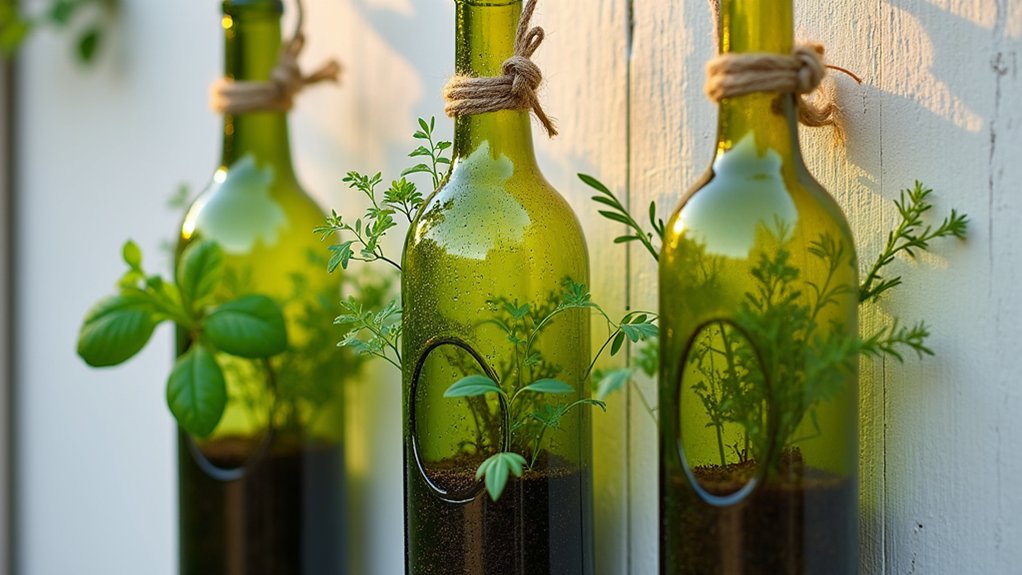
A hanging wine bottle herb garden transforms recycled wine bottles into vertical growing spaces, creating an eye-catching and functional indoor or outdoor garden feature. The bottles are typically suspended horizontally using sturdy rope, wire, or mounting brackets, with their sides cut open to create planting spaces.
Fresh herbs grow outward from these openings, creating a cascading effect of greenery. This space-saving design works particularly well for small balconies, kitchen windows, or garden fences, while the glass bottles add a rustic, eco-friendly aesthetic to any space.
Growing Conditions:
- Bright, indirect sunlight for most herbs, with 4-6 hours of direct sun for Mediterranean varieties
- Well-draining potting soil mixed with perlite to prevent water pooling
- Temperature range of 65-70°F (18-21°C)
- Moderate airflow around plants to prevent moisture-related issues
- Bottle openings should face slightly upward to retain soil while allowing proper drainage
Regular pruning of herbs encourages bushier growth and prevents plants from becoming leggy or overwhelming their containers.
Rotate bottles periodically to ensure even growth, and clean the glass surfaces monthly to prevent algae buildup. Monitor soil moisture carefully, as glass containers can heat up quickly in direct sunlight and accelerate water evaporation.
Remove any yellowing or dead foliage promptly to maintain appearance and prevent disease spread.
Self-Watering Mason Jar Planters
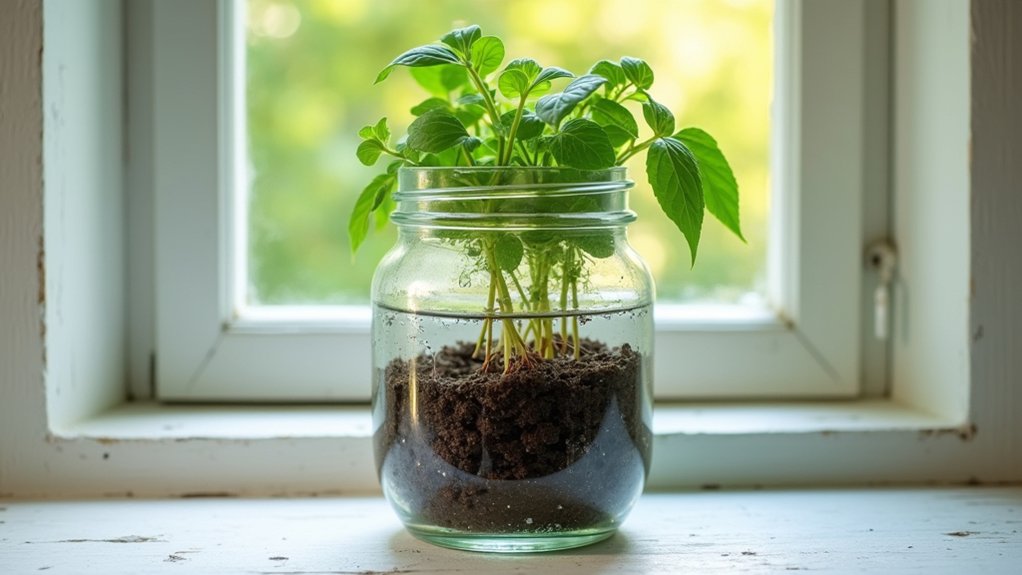
Self-watering mason jar planters are innovative indoor gardening solutions that combine functionality with vintage charm. These planters consist of a mason jar divided into two sections: the bottom reservoir holds water, while the upper portion contains soil and plants. A wicking system, typically made from cotton rope or strips of fabric, connects these sections and delivers water to the plant’s roots as needed, creating an efficient self-sustaining watering system that helps prevent both over- and under-watering.
Growing Conditions:
- Place in bright, indirect sunlight to prevent water algae growth in clear glass
- Maintain water level in reservoir between 1/4 to 1/3 full
- Use well-draining potting soil mixed with perlite
- Choose plants suited for container growing and moderate moisture
- Keep room temperature between 65-75°F (18-24°C)
- Ensure proper airflow around the planter
Regular maintenance of self-watering mason jar planters involves monitoring the water reservoir weekly and refilling when levels drop below one-quarter full. Trim any yellowing or dead foliage promptly to prevent decay, and clean the exterior glass periodically to maintain clarity and aesthetics.
Every few months, check the wicking material for deterioration and replace if necessary to ensure consistent water flow. Fertilize plants quarterly with a balanced, water-soluble fertilizer at half strength to prevent nutrient buildup in the closed system.
Vintage Bottle Succulent Terrariums
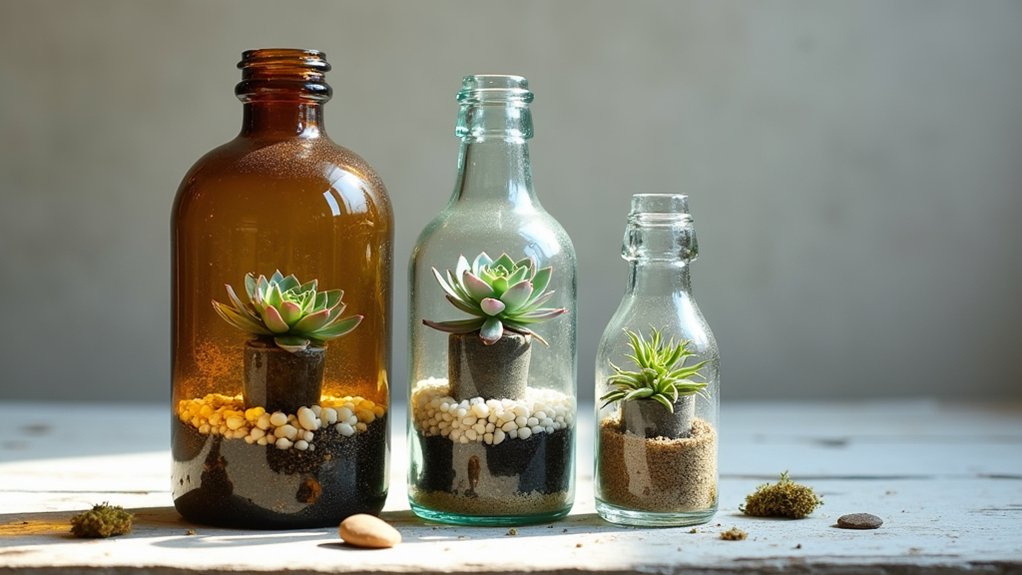
Vintage bottle succulent terrariums transform antique glass vessels into elegant miniature gardens that showcase small desert plants in a charming, repurposed container. These self-contained ecosystems typically feature carefully arranged layers of drainage materials topped with succulent-specific soil and decorated with colored sand, pebbles, or moss.
The bottles’ unique shapes and aged patina create an appealing contrast with the modern, geometric forms of succulents, while the glass walls allow for viewing the intricate root systems and soil layers.
- Light Requirements: Bright, indirect sunlight; avoid direct afternoon sun that can cause heat buildup
- Water Needs: Light watering every 2-3 weeks; allow soil to dry completely between waterings
- Soil Type: Fast-draining cactus/succulent mix
- Drainage: Layer of gravel or pebbles at bottom, minimum 1-inch depth
- Temperature: 60-80°F (15-27°C)
- Humidity: Low to moderate; avoid excessive moisture buildup
- Ventilation: Bottles should have openings wide enough for air circulation
Regular maintenance involves pruning dead leaves and monitoring for signs of rot or pest infestation through the glass.
Remove any fallen leaves promptly to prevent moisture accumulation, and clean the interior glass walls periodically with a long-handled brush to maintain visibility.
When plants outgrow their container, carefully transplant them to larger vessels, taking care not to damage the delicate root systems during the process.
Upcycled Glass Bottle Wall Vases
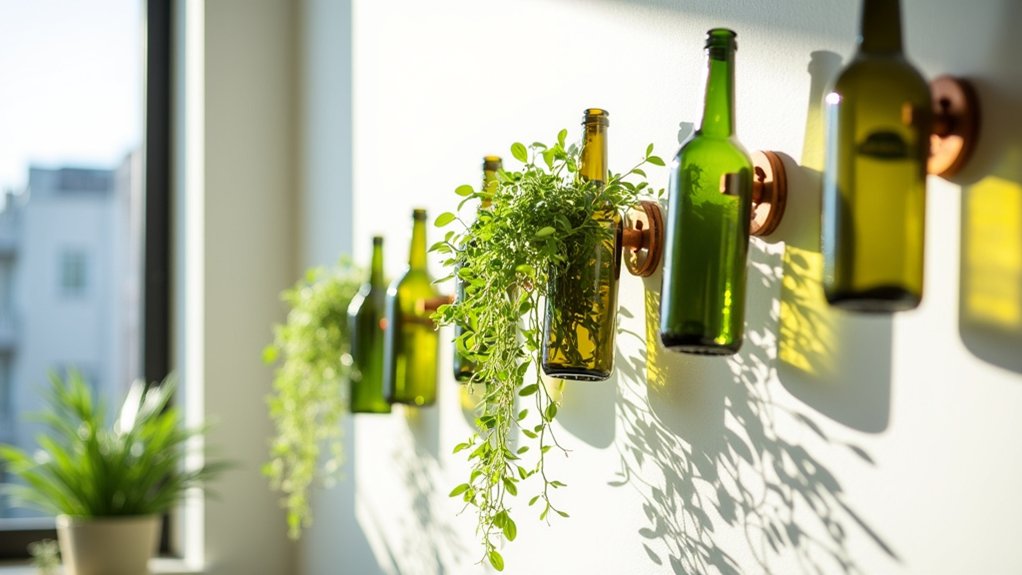
Upcycled glass bottle wall vases transform ordinary wine, beer, or other glass bottles into vertical gardening displays that add dimension and character to indoor or outdoor walls.
These mounted vessels can be arranged in patterns or clusters, with bottles positioned horizontally or at angles to create living artwork. The bottles are typically secured using metal brackets, rope, or specialized bottle holders, allowing plants to grow outward while their roots remain contained within the vessel.
- Light: Most suitable for areas receiving moderate indirect light; avoid direct afternoon sun which can heat the glass
- Water: Requires excellent drainage holes to prevent water accumulation
- Growing Medium: Well-draining potting mix with added perlite or sand
- Temperature: Protected locations between 60-80°F (15-27°C)
- Spacing: At least 8-12 inches between bottles to allow for plant growth
- Position: Mount at eye level or below for easy maintenance
Regular maintenance of bottle wall vases involves checking the security of mounting hardware, cleaning the exterior glass to prevent mineral buildup, and trimming plants to maintain balanced growth.
Since the growing space is limited, fertilize lightly with diluted liquid fertilizer every 4-6 weeks during growing season, and rotate bottles periodically if plants show signs of growing toward light sources.
Remove any fallen leaves or debris that could trap moisture against the mounting surface.
Bottle Propagation Station
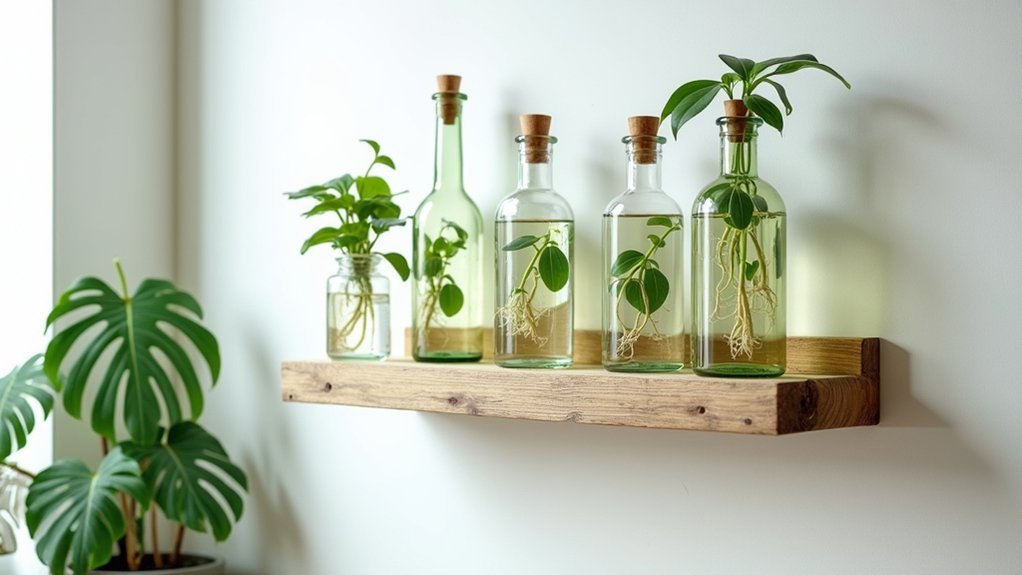
A bottle propagation station transforms recycled glass bottles into an elegant display for propagating plant cuttings in water. These stations typically feature clear glass bottles arranged in a row or cluster, allowing visibility of developing root systems while adding a decorative element to any space.
The bottles can be various sizes and shapes, from wine bottles to small vintage vessels, often secured in wooden stands or hanging from wall-mounted holders, creating an eco-friendly and functional plant nursery.
- Light: Bright, indirect sunlight; avoid direct sun which can promote algae growth
- Water: Clean, room temperature water changed weekly
- Container: Clean glass bottles with narrow necks to support stems
- Temperature: 65-75°F (18-24°C)
- Humidity: Average room humidity (40-60%)
- Space: At least 2 inches between bottles for air circulation
Regular maintenance of a bottle propagation station involves inspecting cuttings for signs of rot, removing any fallen leaves from the water, and wiping bottles clean to prevent mineral buildup.
Once roots develop to 2-3 inches in length, transfer the cuttings to soil-filled containers. Clean and sanitize bottles between uses with a mild bleach solution to prevent bacterial growth, and always use sharp, clean tools when taking new cuttings to ensure successful propagation.
Painted Bottle Centerpiece Gardens
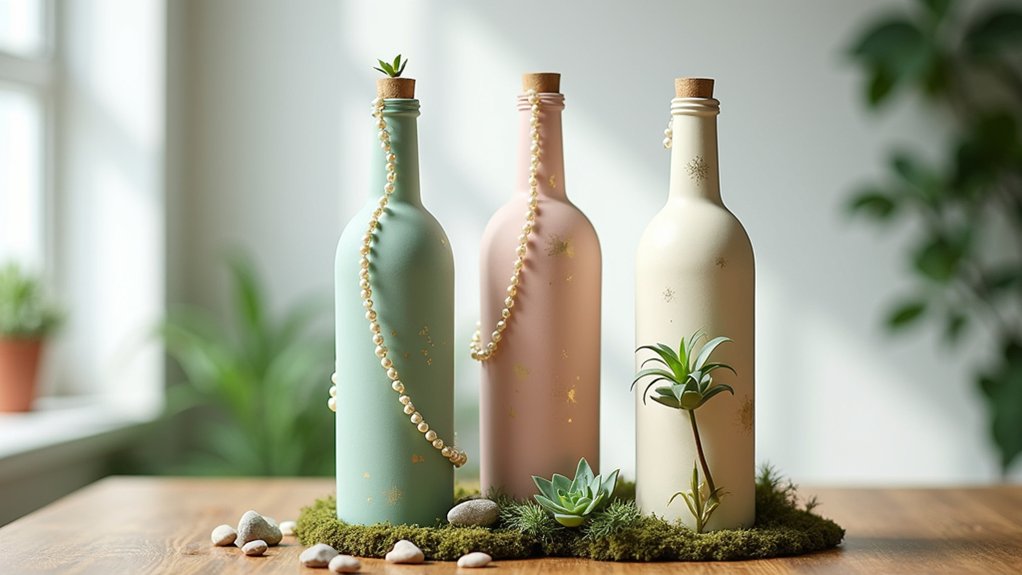
Painted bottle centerpiece gardens transform ordinary glass bottles into eye-catching miniature landscapes by combining decorative painting techniques with carefully selected plants.
These upcycled creations typically feature bottles painted in complementary colors or patterns, arranged in groupings of varying heights and sizes. Small succulents, air plants, or water-propagated cuttings are artfully displayed in these painted vessels, creating striking tablescapes that serve as both functional planters and artistic centerpieces.
Growing Conditions:
- Bright, indirect light – avoid direct sun which can heat up glass
- If using soil, ensure proper drainage with small rocks at bottom
- Water requirements vary by plant type – succulents need less, water plants need frequent changes
- Temperature range of 65-80°F (18-27°C)
- Use lightweight potting mix for soil-based plantings
- Humidity levels between 40-60% for most indoor plants
- Choose compact plants that won’t outgrow container quickly
Regular maintenance involves rotating bottles quarterly for even growth, cleaning the glass surfaces monthly to prevent mineral deposits, and monitoring water levels in water-propagated specimens.
For painted bottles, apply a clear sealant annually to protect the decorative finish from water damage and fading. Remove any yellowing leaves promptly to maintain aesthetics, and trim plants as needed to maintain proportional size relationships between bottles in the grouping.
Glass Bottle Hydroponic Systems
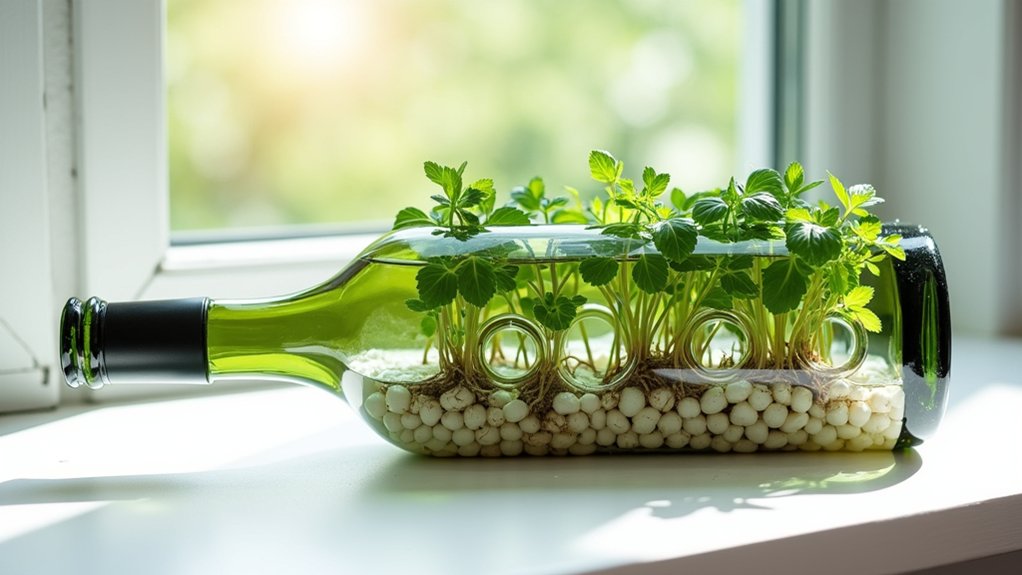
Glass bottle hydroponic systems transform recycled bottles into self-contained growing environments for plants, offering a water-efficient and space-saving solution for indoor gardening.
These systems typically feature bottles positioned horizontally or vertically, with openings cut to accommodate plants and nutrient solution circulation. The transparent nature of glass bottles allows for easy monitoring of water levels and root development, while providing an aesthetically pleasing display that combines functionality with eco-friendly design.
Growing Conditions:
- Light: Bright, indirect sunlight; 6-8 hours daily
- Water: pH-balanced nutrient solution (5.5-6.5 pH)
- Temperature: 65-75°F (18-24°C)
- Humidity: 40-60%
- Growing medium: Clay pebbles, rock wool, or other soil-less medium
- Air circulation: Good ventilation around bottles
- Spacing: Minimum 6 inches between plants
Regular monitoring of nutrient solution levels and concentration is essential for maintaining healthy plants in bottle hydroponic systems.
Clean the bottles monthly with a mild vinegar solution to prevent algae growth and mineral buildup, and check for proper water flow through any irrigation tubes or wicking systems.
Replace the nutrient solution every 2-3 weeks, and trim any roots that may block water circulation.
Inspect plants weekly for signs of nutrient deficiencies or pH imbalances, adjusting the solution as needed.
Macramé Bottle Plant Holders
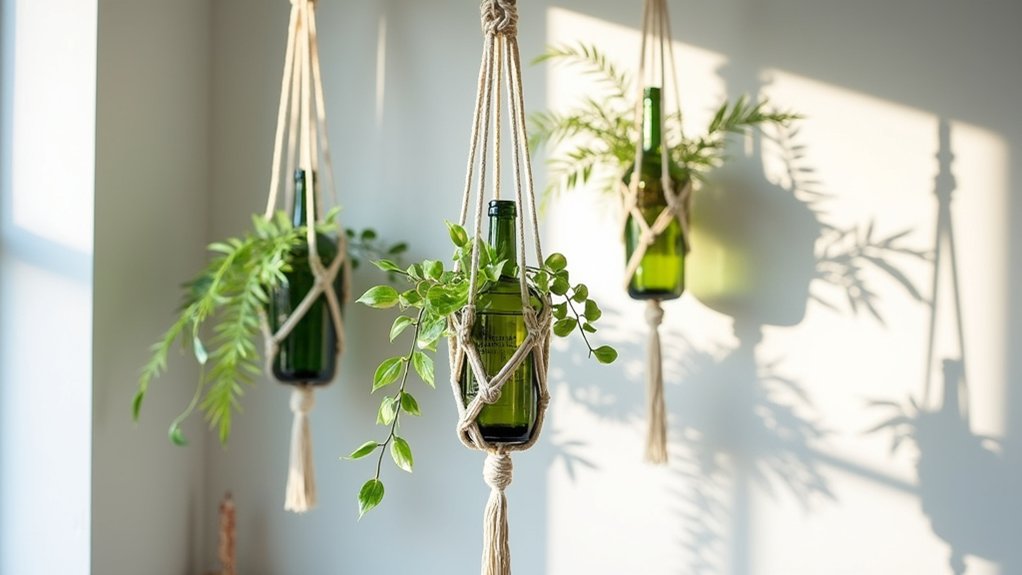
Macramé bottle plant holders combine vintage-inspired rope artistry with repurposed glass bottles to create hanging planters that add bohemian flair to any space.
These decorative holders feature intricate knotted patterns using natural or synthetic cord, suspending glass bottles horizontally or vertically, allowing plants to grow outward through the bottle opening while being securely supported by the woven cradle.
- Light: Best positioned near bright, indirect light; avoid direct sunlight which can heat the glass
- Water: Drainage holes should be added to bottles if possible; otherwise, water sparingly
- Container: Clear or tinted glass bottles, thoroughly cleaned and sterilized
- Support: Strong ceiling hooks or brackets rated for the weight of bottle, water, and plant
- Rope: Weather-resistant cord rated for outdoor use if exposed to elements
- Ventilation: Choose locations with good air circulation to prevent moisture buildup
Regular inspections of both the macramé knots and mounting hardware are essential for safety and longevity.
Periodically check for signs of cord fraying, especially at weight-bearing points, and tighten any loosened knots.
Clean the glass bottle’s exterior monthly to prevent algae growth, and rotate the holder quarterly to ensure even plant growth.
For outdoor installations, consider treating natural fiber cords with water-resistant sealant and bringing holders indoors during severe weather.
Etched Glass Bottle Planters
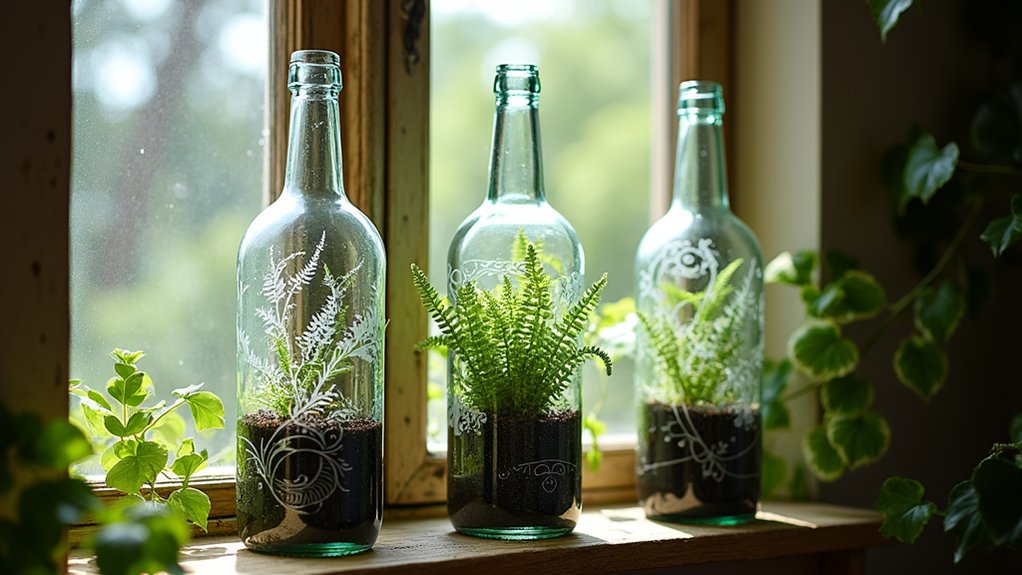
Etched glass bottle planters transform ordinary glass bottles into elegant vessels featuring decorative patterns, designs, or text permanently carved into their surface through chemical or mechanical etching processes.
These unique planters can be created from wine bottles, mason jars, or other glass containers, offering a sophisticated and personalized touch to indoor plant displays while maintaining transparency to monitor root health and soil moisture levels.
- Light: Varies based on plant selection; place bottles where they receive filtered light to prevent water temperature fluctuations
- Drainage: Must have drainage holes drilled into bottom
- Container size: Generally 750ml-1.5L capacity
- Soil type: Well-draining potting mix suitable for chosen plant
- Humidity: Glass helps maintain moisture levels around plants
- Temperature: Keep away from cold drafts or intense heat to prevent temperature shock
Regular maintenance of etched glass bottle planters involves cleaning the exterior surface with a gentle glass cleaner to maintain the etched design’s visibility and prevent mineral deposits from water spots.
Check the drainage holes periodically to ensure they remain clear and unclogged, and rotate the bottles quarterly to promote even plant growth.
When watering, use a narrow-spouted watering can or spray bottle to prevent water from splashing onto the etched design, which could lead to mineral buildup in the etched areas.
Stacked Bottle Vertical Gardens
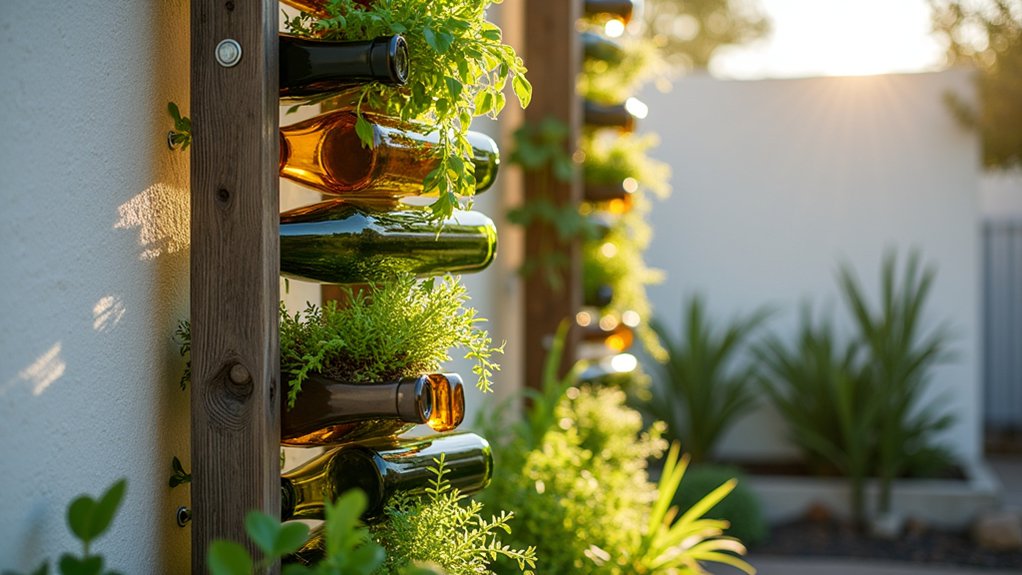
Stacked bottle vertical gardens create an eye-catching display by arranging recycled glass bottles horizontally in a tower-like formation, typically secured with a strong adhesive or mounted on a supportive frame.
These innovative structures maximize growing space in small areas while adding architectural interest, with each bottle opening serving as an individual planting pocket. The bottles can be arranged in various patterns, from straight columns to spiral designs, allowing plants to grow outward from multiple angles.
- Light: Position in bright, indirect sunlight; morning sun preferred
- Water: Weekly watering with good drainage through bottle openings
- Soil: Lightweight potting mix with perlite for adequate aeration
- Temperature: 60-75°F (15-24°C)
- Spacing: 6-8 inches between bottle openings
- Support: Secure mounting to wall or sturdy frame required
- Container Size: Use bottles 750ml or larger for adequate root space
Regular maintenance involves checking the stability of bottle connections and ensuring proper water flow through the system.
Trim plants regularly to prevent overcrowding and maintain balanced growth throughout the structure. Monitor for water pooling at the bottom of bottles and clear any drainage blockages immediately.
Rotate the structure periodically if possible to ensure even light exposure, and inspect mounting hardware or adhesive bonds monthly to maintain structural integrity.
